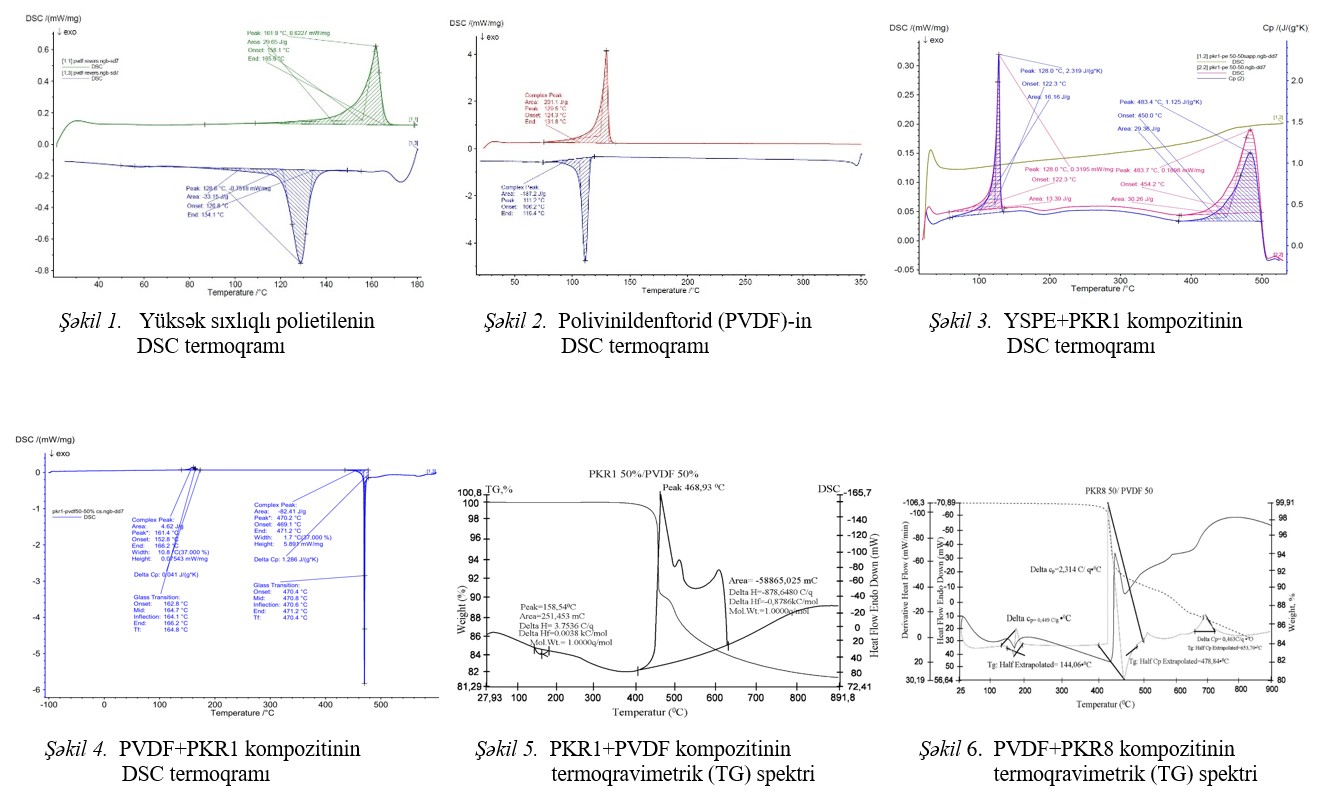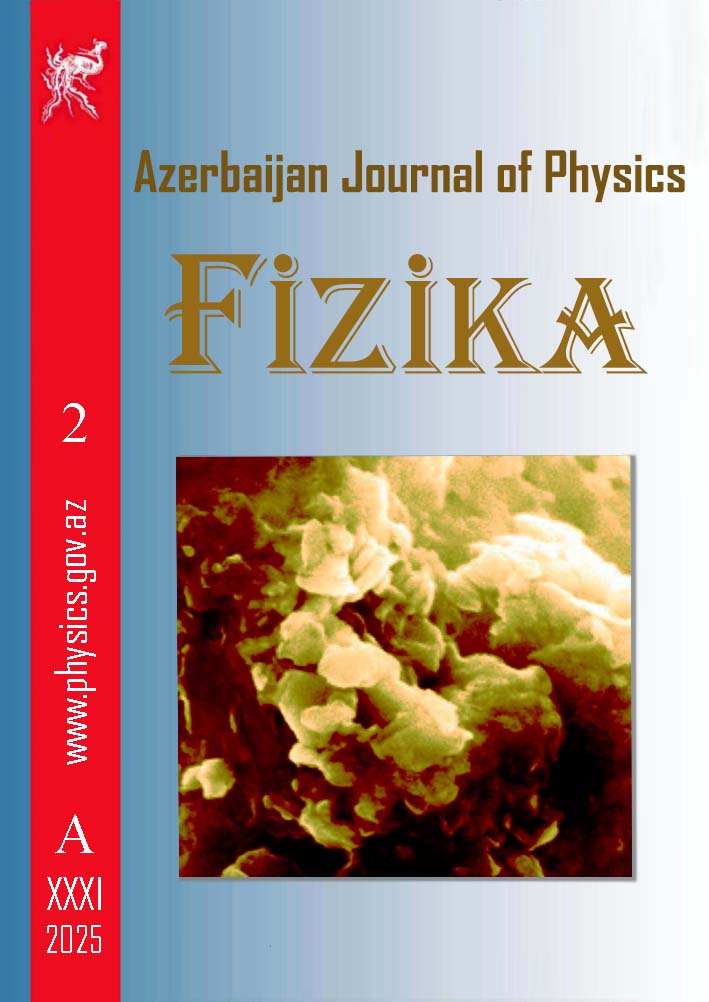ABSTRACT
Interphase interaction in composites consisting of polar (PVDF) and non-polar (HDPE) polymer matrix and ceramics with different structures (PZT1- rhombohedral, PZT8-
tetragonal) was studied by differential scanning calorimetry (DSC) and thermogravimetric analysis methods (TGA). Through DSC analyses, the interactions between the matrix
and the filler in the composites, phase transitions and changes in the crystal structure were studied. It was determined that the type, amount and degree of dispersion of
the filler have a significant effect on the thermal stability and phase transition of the composites. Mass loss and thermal stability of composites consisting of
piezoceramics with different structures were also evaluated by the TGA method, and the effect of interactions occurring at the interphase boundary on the overall thermal
parameters of the composite was determined. The obtained results show that the type, quantity and dispersion of the filler have a significant effect on the interaction and
decomposition stages of the composites.
Keywords: polymer, composite, matrix, glass transition, enthalpy, entropy, mass loss, plasma, specific heat capacity.
DOI:10.70784/azip.2.2025124
Received: 26.02.2025
Internet publishing: 01.04.2025 AJP Fizika A 2025 01 az p.24-31
AUTHORS & AFFILIATIONS
Institute of Physics Ministry of Science and Education Republic of Azerbaijan, 131 H.Javid ave. Baku, AZ 1073
E-mail: dadashov.zamir87@gmail.com
Graphics and Images

Fig.1-2-3-4-5-6
|
[1] Jurgen Rodel, Wook Jo, Klaus T. P. Seifert, Eva-Maria Anton. Perspective on the Development of Lead-free Piezoceramics. Journal of the American Ceramic Society. Vol. 92, № 6. pp. 1153-1177, 2009.
[2] P. Noorunnisa Khanam, Mariam Al Ali Al Maadeed. Processing and characterization of polyethylene-based composites. Adv. Manuf.: Polym. Compos. Sci., 2015, 1, 63-79.
[3] N.M. Nurazzi, M.R.M. Asyraf, M. Rayung. Thermogravimetric Analysis Properties of Cellulosic Natural Fiber Polymer Composites: A Review on Influence of Chemical Treatments. Polymers 2021, 13, 2710.
[4] Beatriz Adriana Salazar-Cruz, María Yolanda Chávez-Cinco, Ana Beatriz Morales-Cepeda. Evaluation of Thermal Properties of Composites Prepared from Pistachio Shell Particles Treated Chemically and Polypropylene. Molecules 2022, 27, 426. pp1-12.
[5] Carmen Albano, Gema González, Jordana Palacios, Arquímedes Karam. characterization of poly l-lactide/hydroxyapatite composite: chemical, thermal and thermomechanical properties. Revista de la Facultad de Ingeniería U.C.V., Vol. 28, № 3, pp. 97-108, 2013.
[6] Luciano Pisanu, Josiane Barbosa, Ricardo Souza and Marcio Nascimento. Evaluating the influence of coupling agents in the structural properties of polypropylene coconut fiber composites. Mater. Res. Express 6, 2019, 11532.
[7] César Leyva-Porras, Pedro Cruz-Alcantar, Vicente Espinosa-Solís. Application of Differential Scanning Calorimetry (DSC) and Modulated Differential Scanning Calorimetry (MDSC) in Food and Drug Industries. Polymers 2019, 12, 5.
[8] Raluca Maria Florea, Ioan Carcea. Polymer matrix composites – routes and properties. International Journal of Modern Manufacturing Technologies ISSN 2067–3604, Vol.IV, № 1/20.
[9] X.J. Fan, S.W.R. Lee, Q. Han. Experimental investigations and model study of moisture behaviors in polymeric materials. Microelectronics Reliability 49, 2009, 861–871.
[10] Carola Esposito Corcione and Mariaenrica Frigione. Characterization of Nanocomposites by Thermal Analysis. Materials 2012, 5, 2960-2980.
[11] Hassan Omar, Glen J. Smales, Sven Hennin. Calorimetric and Dielectric Investigations of Epoxy-Based Nanocomposites with Halloysite Nanotubes as Nanofillers. Polymers 2021, 13.
[12] Jérémie Audoit, Lisa Rivière, Jany Dandurand, Antoine Lonjon, Eric Dantras, Colette Lacabanne. Thermal, mechanical and dielectric behaviour of poly (aryl ether ketone) with low melting temperature. Journal of Thermal Analysis and Calorimetry, Springer Verlag, 2019, 135 (4), pp.2147-2157
[13] Mateusz Bor, Tomasz Borowczyk, Wojciech Karpiuk, Mikołaj Krakowiak, Rafał Smolec. Assessment of the possibility of applying ceramic materials in common rail injection systems. Advances in Science and Technology Research Journal Volume 12, Issue 1, March 2018, pages 312–321.
[14] Franziska Eichhorn, Simone Kellermann, Ulf Betke and Tobias Fey. Phase Evolution, Filler-Matrix Interactions, and Piezoelectric Properties in Lead Zirconate Titanate (PZT)-Filled Polymer-Derived Ceramics (PDCs). Materials 2020, 13, 1520; doi:10.3390/ma13071520. pp. 1-14.
[15] В.М. Егоров. Калориметрия твердых растворов (1-х)BaTiO3-xBa(Mg1/3Nb2/3)O3. В.М.Егоров, Е.П. Смирнова, В.В. Леманов. Физика и Техника Полупроводников, 2007, т.49, вып8, с. 1456-1459.
[16] Ю.И. Юрасов, А.В. Назаренко, А.В. Павленко, И.А. Вербенко. Прогнозирование свойств бессвинцовых пьезокерамик и модификация конструкции вибродатчиков на основе свинец¬со-держащих композиций. Наука юга России 2017, Т. 13 № 4 С. 23–31
|
